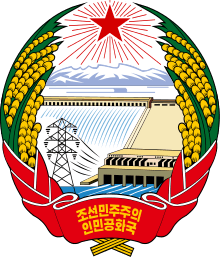Supreme Guard Command
| Supreme Guard Command | |
|---|---|
| Active | 1946 - Present |
| Country |
|
| Allegiance | Korean Worker's Party |
| Branch | Korean People's Army Ground Force |
| Type | Protective security unit |
| Role | Protection of domestic VIPs and the Kim family and high-ranking KWP officials |
| Size | 95,000-120,000 |
| Engagements | Korean War |
| Commanders | |
| Supreme Guard Commander | General Yun Jong Rin |
 |
| This article is part of a series on the politics and government of North Korea |
|
|
| Foreign relations |
Supreme Guard Command (also known as Unit 963, the Escort Bureau,[1] Guard Command,[2] Guard Bureau[3] and the General Guard Bureau[4]) is the personal bodyguard force tasked with the protection of North Korea's ruling Kim family.[5] The current Supreme Guard commander is General Yun Jong Rin.[6]
Naming
North Korea's ruling family are claimed to be superstitious and so the Command's designation number is in reference to the numerological construct "9 and 6+3=9" (double nine), whereas the number "9" is considered lucky.[7][8]
History
According to official history, the Command participated in the Korean War (known in North Korea as the "Fatherland Liberation War"). The unit has also produced 72 "heroes of labor" and 28 "heroes of the Republic".[9]
The first incarnation of the Command was created in 1946. Between 1970-mid 1990's the Command was part of the State Security Department. However, to deal with several coups attempts, Kim Jong-il reorganized the Guard by dismissing dozens of officers and expanding his own private bodyguard unit by 200 men and named it the "2.16 Unit".[6]
Organization
The Command falls under the Korean People's Army Ground Force and is divided into approximately six departments, three combat brigades, several bodyguard divisions, and one construction battalion.[6] The unit is composed of 95,000-120,000 personnel.[6]
Bodyguard divisions are divided into at least two sections, Section 1 was dedicated to the protection of Kim Il-sung and Section 2 protected Kim Jong-il.[7] It is unknown if Kim Jong-un has a new dedicated section.
The Command has camps located throughout the country, usually near official residences, and has a strong presence in Pyongyang. The Command also monitors key military and party figures to ensure the safety of the Kim family.[1] It also coordinates with the Pyongyang Defense Corps and III Army Corps for the defense of the capital and other strategic locations.[6] These other military units provide an additional 95,000-100,000 soldiers, with their included artillery and armored vehicles, for the defense of the country's leadership.[10]
Recruitment and training
According to the testimonies of Lee Young-kuk, recruiters for the Guard look for new recruits in high schools where students are lined up for inspection. Physical prerequisites include, no facial scars and a well-proportioned body. Potential candidates have their family histories scrutinized for party loyalty and good "songbun". Once chosen, they are given an ID number while all other records are erased; contact with family is forbidden.[11] Only one member per family is allowed to serve as a bodyguard.[11]
Recruits are then taken to special training camps for six months and are trained for a total of two years.[12] Training includes, Taekwondo classes, marksmanship, 25 km marches in full gear and special operations tactics.[11] According to defector Oh Young-nam, a former member of the State Security Department, the Supreme Guard Command published a 300-page training book detailing previous security incidents.[13]:547
Known members
References
- 1 2 Moon Sung Hwee (September 16, 2008). "Watch Escort Bureau, Learn of Kim's Successor". Daily NK. Retrieved April 13, 2013.
- ↑ http://www.cna.org/sites/default/files/research/ipr_15163.pdf
- ↑ https://wikileaks.org/plusd/cables/1976STATE207521_b.html
- ↑ http://globalpublicsquare.blogs.cnn.com/2012/12/06/kim-jong-un-tightens-his-grip/
- ↑ "Kim Jong il's visit to KPA Unit 963". North Korean Economy Watch. July 18, 2011. Retrieved April 13, 2013.
- 1 2 3 4 5 "Guard Command". North Korea Leadership Watch. April 29, 2012. Retrieved April 13, 2013.
- 1 2 "Insider exclusive: What guides the decision-making of Kim Jong-un?". New Focus International. March 31, 2013. Retrieved April 13, 2013.
- ↑ Jang Jin-sung (April 5, 2013). "In North Korea, nine is the magic number". The Guardian. Retrieved April 13, 2013.
- ↑ Kang Mi Jin (July 14, 2011). "Kim Jong Il Hits Escort Command Base". Daily NK. Retrieved April 13, 2013.
- ↑ Michael Madden (October 31, 2013). "Was a North Korean General Really Executed by Mortar Fire?". Foreign Policy. Retrieved January 22, 2014.
- 1 2 3 4 Donald MacIntyre (February 18, 2002). "The Supremo in His Labyrinth". Time Magazine. Retrieved April 13, 2013.
- ↑ John M. Glionna (February 20, 2011). "Kim Jong Il's guard set himself free". Los Angeles Times. Retrieved April 13, 2013.
- 1 2 Martin, Bradley (2006). Under the Loving Care of the Fatherly Leader. New York, New York, USA: Thomas Dunne Books. ISBN 0-312-32322-0.
Bibliography
- Bermudez Jr., Joseph S. (2001-03-14). The Armed Forces of North Korea. I.B. Tauris. ISBN 1-86064-486-4.